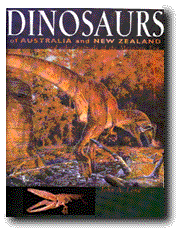Dinosaurs of Australia and New Zealand and Other Animals of the Mesozoic Era
by John A. Long
Harvard University Press, 1998, 188 pp.
ISBN: 0-647-20767-X,

|
 |
Among the multitude of books on fossils, this work stands out as one of the few that focuses on vertebrate fossils from Australia and New Zealand. This work contains a complete catalogue of the area's Mesozoic tetrapods (amphibians, reptiles, birds, and mammals), including specimens that consist of isolated bones as well as footprints and trackways. The text is illustrated throughout with full-color illustrations and photographs of not only the specimens discussed, but also many of the sites from which fossils were recovered. Anyone interested in the prehistoric life of Australia or New Zealand will find this book appealing. However, readers searching for an intriguing book about dinosaurs will likely be disappointed, in part because this region has yielded relatively few dinosaurs specimens (less than 20 species have been identified).
The book is divided into four sections, the first of which includes three chapters aimed primarily at readers without an extensive background in paleontology. The first two chapters provide an introduction to the major concepts needed to put fossils into context. Included are brief overviews of fossilization, geologic time, and plate tectonics, as well as a more detailed description of cladistics and the evolution of dinosaurs. The material is nicely written and well illustrated. General readers should find the subject matter easily accessible, although readers already familiar with the concepts discussed may prefer to skim ahead. The third chapter covers the history of vertebrate paleontology in Australia/New Zealand and provides a bridge into the rest of the book. Long has meticulously researched his subject matter and includes a detailed account of everyone who has contributed to the discovery or study of fossil vertebrates in this region. Professional paleontologists may find that this chapter serves as a useful reference tool, but the causal reader is likely to quickly bog down as many sections consist of little more than lists of people and/or institutions.
The remaining sections of the book are devoted to describing the fossils. Each section covers specimens of a given geologic time period (Triassic, Jurassic, or Cretaceous) and is organized taxonomically. In spite of the title of this work, the vast majority of specimens described are not dinosaurs, but rather amphibians and aquatic reptiles. A few specimens of pterosaurs, birds, and mammals have also been identified and are discussed. However, as most of the latter, as well as many of the dinosaurs species, are known only from isolated and/or fragmentary bones. there is often relatively little that can be said about them.
Descriptions of all specimens are presented in the same format. First, Long provides a detailed history of the discovery and study of each specimen, then he describes its general physical characteristics. Each species is accompanied by photographs or diagrams of prepared specimens. Also included are summaries defining the synapomorphies of each species. This catalogue will serve as a valuable resource for researchers looking for detailed information on the occurrence or study of fossil vertebrates, as well anyone interested in trying to identify fossil specimens. However, the technical terms and terminology used in this section may be difficult for general readers to decipher. Additionally, relatively little information is presented on the paleobiology or paleoecology of these animals. It is thus often difficult to put specimens in context.
In summary, this book presents a detailed account of the tetrapod fauna and the work of vertebrate paleontologists from a region that has been largely overlooked by most publications. It fills a valuable role and will serve as a useful reference tool for paleontologists interested in the fossils of this region.
Copyright: Palaeontologia Electronica, 15 April 2000